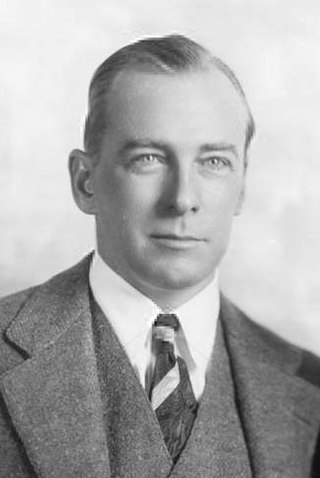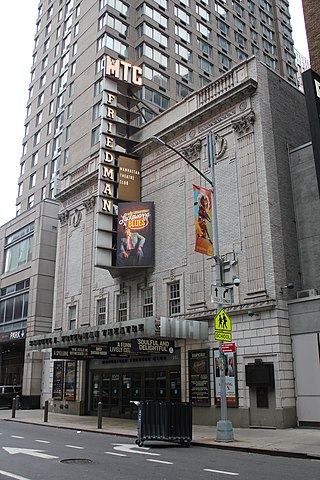
The Front Page is a Broadway comedy about newspaper reporters on the police beat. Written by former Chicago reporters Ben Hecht and Charles MacArthur, it was first produced in 1928 and has been adapted for the cinema several times. The play's copyright is set to expire in 2024 in the United States, and subsequently the play will enter the public domain.

George Francis Abbott was an American theatre producer, director, playwright, screenwriter, film director and producer whose career spanned eight decades. He received numerous honors including six Tony Awards, the Pulitzer Prize, the Kennedy Center Honors in 1982. the National Medal of Arts in 1990. and was inducted into the American Theatre Hall of Fame.

Susan P. Stroman is an American theatre director, choreographer, film director and performer. Her notable theater productions include Oklahoma!, The Music Man, Crazy for You, Contact, The Producers, The Frogs, The Scottsboro Boys, Bullets Over Broadway, POTUS: Or, Behind Every Great Dumbass Are Seven Women Trying to Keep Him Alive, and New York, New York.

Joseph Calleia was a Maltese-born American actor and singer on the stage and in films, radio and television.

The Bernard B. Jacobs Theatre is a Broadway theater at 242 West 45th Street in the Theater District of Midtown Manhattan in New York City. Opened in 1927, the theater was designed by Herbert J. Krapp in a Spanish style and was built for real-estate developer Irwin S. Chanin. It has 1,100 seats across two levels and is operated by The Shubert Organization. Both the facade and the auditorium interior are New York City landmarks.

Fiorello! is a musical about New York City mayor Fiorello La Guardia, a reform Republican, which debuted on Broadway in 1959, and tells the story of how La Guardia took on the Tammany Hall political machine. The book is by Jerome Weidman and George Abbott, drawn substantially from the 1955 volume Life with Fiorello by Ernest Cuneo, with lyrics by Sheldon Harnick, and music by Jerry Bock. It won the three major theatre awards - Tony Award, the New York Drama Critics Circle award, and the Pulitzer Prize for Drama. It is one of only ten musicals to win the latter award.

The Gerald Schoenfeld Theatre, formerly the Plymouth Theatre, is a Broadway theater at 236 West 45th Street in the Theater District of Midtown Manhattan in New York City. Opened in 1917, the theater was designed by Herbert J. Krapp and was built for the Shubert brothers. The Schoenfeld Theatre is named for Gerald Schoenfeld, longtime president of the Shubert Organization, which operates the theater. It has 1,079 seats across two levels. Both the facade and the auditorium interior are New York City landmarks.

The Music Box Theatre is a Broadway theater at 239 West 45th Street in the Theater District of Midtown Manhattan in New York City. Opened in 1921, the Music Box Theatre was designed by C. Howard Crane in a Palladian-inspired style and was constructed for Irving Berlin and Sam H. Harris. It has 1,025 seats across two levels and is operated by The Shubert Organization. Both the facade and the auditorium interior are New York City landmarks.

The John Golden Theatre, formerly the Theatre Masque and Masque Theater, is a Broadway theater at 252 West 45th Street in the Theater District of Midtown Manhattan in New York City. Opened in 1927, the Golden Theatre was designed by Herbert J. Krapp in a Spanish style and was built for real-estate developer Irwin S. Chanin. It has 800 seats across two levels and is operated by The Shubert Organization. Both the facade and the auditorium interior are New York City landmarks.

The Broadhurst Theatre is a Broadway theater at 235 West 44th Street in the Theater District of Midtown Manhattan in New York City. Opened in 1917, the theater was designed by Herbert J. Krapp and was built for the Shubert brothers. The Broadhurst Theatre is named for British-American theatrical producer George Broadhurst, who leased the theater before its opening. It has 1,218 seats across two levels and is operated by The Shubert Organization. Both the facade and the auditorium interior are New York City landmarks.

The Booth Theatre is a Broadway theater at 222 West 45th Street in the Theater District of Midtown Manhattan in New York City. Opened in 1913, the theater was designed by Henry Beaumont Herts in the Italian Renaissance style and was built for the Shubert brothers. The venue was originally operated by Winthrop Ames, who named it for 19th-century American actor Edwin Booth. It has 800 seats across two levels and is operated by The Shubert Organization. The facade and parts of the interior are New York City landmarks.

The Samuel J. Friedman Theatre, formerly the Biltmore Theatre, is a Broadway theater at 261 West 47th Street in the Theater District of Midtown Manhattan in New York City. Opened in 1925, it was designed by Herbert J. Krapp in the neo-Renaissance style and was constructed for Irwin Chanin. It has 650 seats across two levels and is operated by the Manhattan Theatre Club (MTC). The auditorium interior is a New York City landmark, and the theater is listed on the National Register of Historic Places. Since 2008, the theater has been named for Broadway publicist Samuel J. Friedman, whose family was a major donor to MTC.

Jed Harris was an Austrian-born American theatrical producer and director. His many successful Broadway productions in the 1920s and 1930s include Broadway (1926), Coquette (1927), The Royal Family (1927), The Front Page (1928), Uncle Vanya (1930), The Green Bay Tree (1933) and Our Town (1938). He later directed the original Broadway productions of The Heiress (1947) and The Crucible (1953).

Twentieth Century is a 1932 play by Ben Hecht and Charles MacArthur based on the unproduced play Napoleon of Broadway by Charles B. Millholland, inspired by his experience working for the eccentric Broadway impresario David Belasco.
The Heiress is a 1947 play by American playwrights Ruth and Augustus Goetz adapted from the 1880 Henry James novel Washington Square. Two years later, the play was adapted into the film The Heiress starring Olivia de Havilland.

The Last Mile is a Broadway play by John Wexley that ran for 289 performances from February 13, 1930, to October 1930 at the Sam H. Harris Theatre. It was produced by Herman Shumlin and staged by Chester Erskine. It is set in the death row wing of a prison. The lead role of John "Killer" Mears was first played by Spencer Tracy, and it was the role that brought him to the attention of Hollywood. It was later played for a time by Clark Gable on tour. The play was adapted into a 1932 film starring Preston Foster and into a 1959 film starring Mickey Rooney.

A Raisin in the Sun is a play by Lorraine Hansberry that debuted on Broadway in 1959. The title comes from the poem "Harlem" by Langston Hughes. The story tells of a black family's experiences in south Chicago, as they attempt to improve their financial circumstances with an insurance payout following the death of the father, and deals with matters of housing discrimination, racism, and assimilation. The New York Drama Critics' Circle named it the best play of 1959, and in recent years publications such as The Independent and Time Out have listed it among the best plays ever written.

The 48th Street Theatre was a Broadway theatre at 157 West 48th Street in Manhattan. It was built by longtime Broadway producer William A. Brady and designed by architect William Albert Swasey. The venue was also called the Equity 48th Street Theatre (1922–25) and the Windsor Theatre (1937–43).

Small Miracle is a 1934 play by Norman Krasna, presented on Broadway with Joseph Calleia in the featured role. Directed by George Abbott with a single setting designed by Boris Aronson, the three-act melodrama opened September 26, 1934, at the John Golden Theatre, New York. It continued at the 48th Street Theatre November 11, 1934 – January 5, 1935. On February 7, 1935, the play began a run at the El Capitan Theatre in Hollywood, with Calleia, Joseph King and Robert Middlemass reprising their Broadway roles.

Warner Bros. Theatre Ventures is the live show, stageplay and musical production arm of Warner Bros. Discovery. The company forms a part of Warner Bros., one of the major business segments of Warner Bros. Discovery. Warner Bros. Theatre Ventures is led by Mark Kaufman.




















